From the Trenches
A Pharaoh’s Last Fleet
By JASON URBANUS
Monday, December 12, 2016
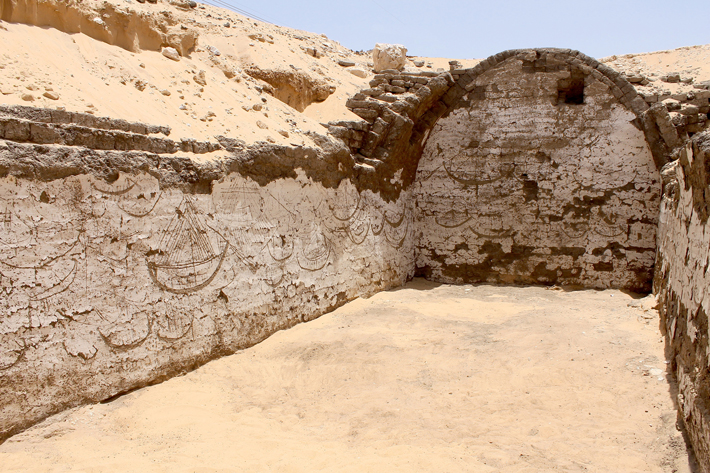
Over the past three years, archaeologists from the University of Pennsylvania Museum of Archaeology and Anthropology have been excavating an ancient Egyptian boat burial in Abydos. Although very little of the actual vessel survives, it was originally interred in a vaulted subterranean mudbrick building. The site dates to around 1850 B.C., and is believed to have been part of the elaborate funerary complex of the 12th Dynasty king Senusret III. “Boats were used during funerary ceremonies and took on a magical significance,” says lead archaeologist Josef Wegner. “The boats used in this way were ritually buried as a means of emphasizing this symbolic connection with the deceased.”
The team recently uncovered a decorative tableau that was incised into the white plaster walls along the interior of the boat building. The surviving scene extends for over 80 feet and depicts more than 120 ancient Egyptian watercraft, along with animals and floral motifs. The renditions of the boats range in size and complexity, with the largest measuring five feet long, with finely detailed masts, sails, rigging, and deckhouses. Researchers are still unsure who made these etchings, as the images do not compose a single unified scene, but appear to have been created by several different hands of varying talent. It is likely that the carvings were left by individuals who were involved in the funerary ceremonies and participated in depositing the boat.
Off the Grid
By MALIN GRUNBERG BANYASZ
Monday, December 12, 2016
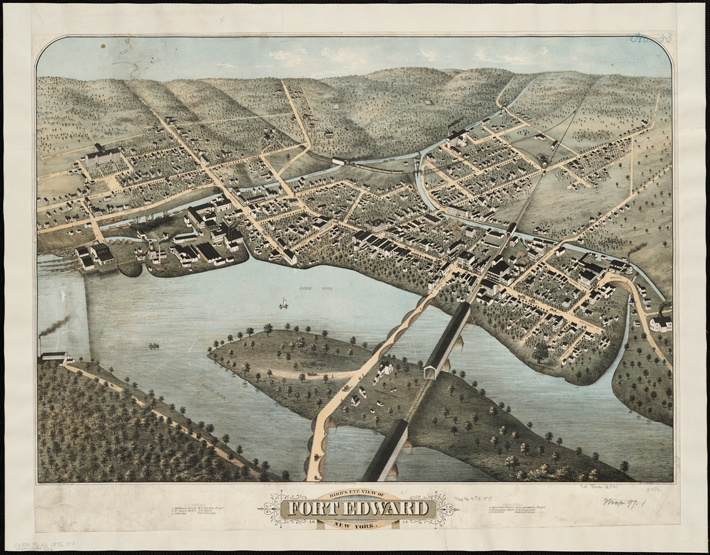
Rogers Island, in the middle of New York’s Hudson River about an hour north of Albany, is part of a large eighteenth-century fort and supply base built by the British in 1755 and used throughout the French and Indian War (1754–1763). During that time, expansion of the fort—to accommodate at least 16,000 soldiers—made the island and the riverbank village of Fort Edward the largest city in colonial North America, after New York and Philadelphia. Many consider the fort to be the spiritual home of the U.S. Army Rangers, as that was where Major Robert Rogers wrote his 28 “Rules of Ranging” in 1757 to dictate principles of reconnaissance and guerilla forest warfare. (Number 21: “If the enemy pursue your rear, take a circle till you come to your own tracks, and there form an ambush to receive them, and give them the first fire.”) The tactics proved very effective and still appear in the U.S. Army Ranger Handbook. David Starbuck of Plymouth State University says, “Archaeology is now helping to develop trails and outdoor exhibits that will highlight daily life on the early American frontier. Unlike so many forts and battlefields, Rogers Island will tell the very human story of soldiers’ lives as they camped, drilled, and prepared to fight.”
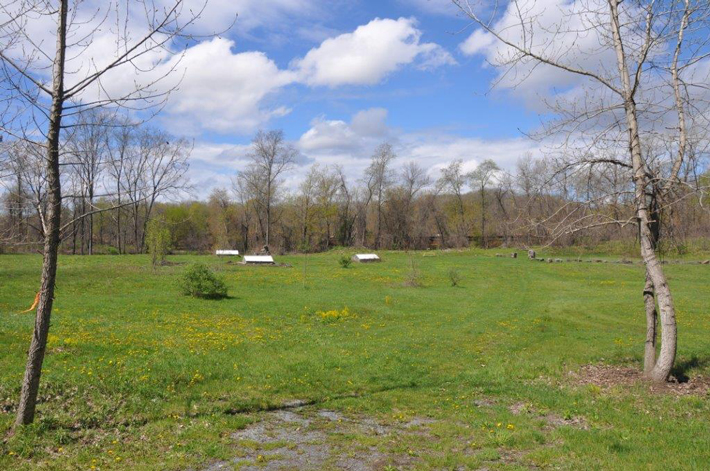 THE SITE
THE SITE
Rich prehistoric sites have been found on the island and east bank of the river, where Native Americans hunted and fished from about 4000 B.C. until Europeans arrived in the eighteenth century. The fort and base spanned both the island and the village on the bank. Some portions were built over—homeowners in Fort Edward have found military artifacts and bricks in their basements—but the southern half of Rogers Island was spared modern settlement and is one of the most intact sites from the French and Indian War. Excavations began in 1991 and continue, having investigated huts and barracks, the oldest smallpox hospital excavated in North America, and a merchant’s house. The visitors’ center on the island displays many of the artifacts that have been uncovered.
WHILE YOU'RE THERE
The Old Fort House Museum in Fort Edward is a complex of buildings with historical artifacts and reconstructions dating from the 1770s to the 1940s. Fort William Henry, 13 miles away in Lake George, was, along with Fort Edward, a setting for James Fenimore Cooper’s The Last of the Mohicans, and features both a museum and living history exhibits. The lake is host to a variety of other recreational activities, including hot-air ballooning.
Proteins Solve a Hominin Puzzle
By NIKHIL SWAMINATHAN
Monday, December 12, 2016
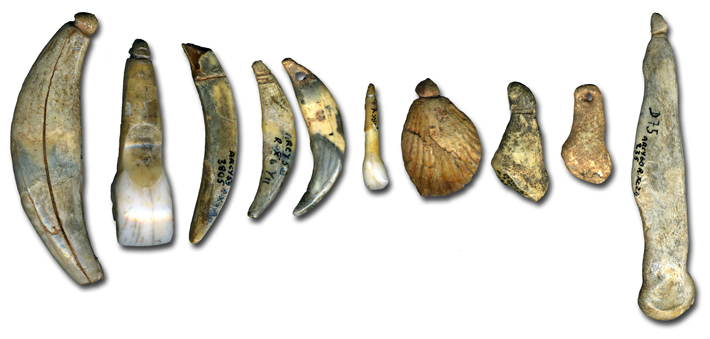
Around 40,000 years ago, modern humans made their way into Europe, sweeping through the continent and, eventually, driving to extinction our close relatives, the Neanderthals. Exactly how that process took place is still up for debate. Tangled up in that conversation are questions about the sophistication of Neanderthals, including whether they were capable of artistic expression, or made jewelry or complex stone tools.
Archaeologists agree that hand axes and scrapers were definitely part of the Neanderthal toolkit, and modern humans are credited with developing points made of bone and antler, as well as flint blades. But in between these two types of technology, chronologically, are the so-called Châtelperronian tools, characterized by sawtooth edges and knives with convex backs. Researchers are still unsure which hominin was responsible for them.
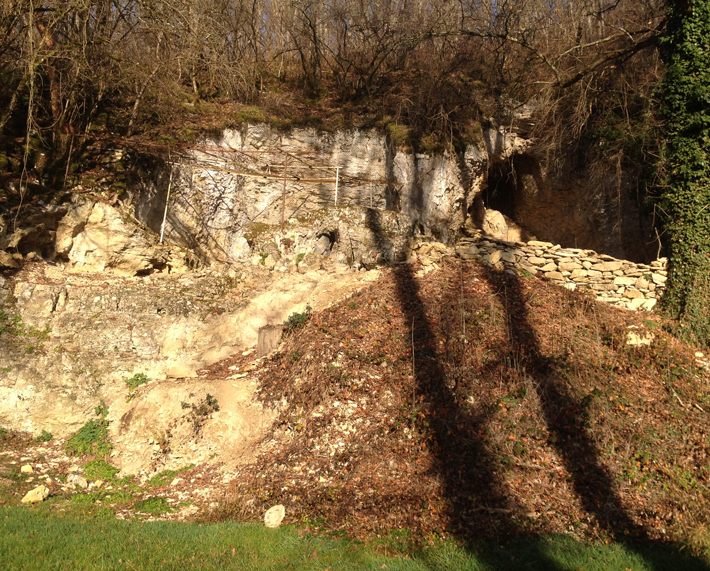 Scientists from the Max Planck Institute for Evolutionary Anthropology in Leipzig, Germany, applied a relatively new technique—probing ancient bones for the remains of proteins—to solve the riddle at the Grotte du Renne, a cave located 150 miles southeast of Paris. Châtelperronian tools were discovered there, mostly in the 1950s, in association with ornaments such as bead necklaces and pendants, as well as hominin remains. The jewelry implies the deposit was made by modern humans, but the bones appear to be those of Neanderthals.
Scientists from the Max Planck Institute for Evolutionary Anthropology in Leipzig, Germany, applied a relatively new technique—probing ancient bones for the remains of proteins—to solve the riddle at the Grotte du Renne, a cave located 150 miles southeast of Paris. Châtelperronian tools were discovered there, mostly in the 1950s, in association with ornaments such as bead necklaces and pendants, as well as hominin remains. The jewelry implies the deposit was made by modern humans, but the bones appear to be those of Neanderthals.
Proteins are more robust than DNA, so they persist longer in bone, especially in warmer climates. The human and Neanderthal genomes—and, in turn, proteins—are nearly the same, so the team was on the hunt for small differences. “If you have a choice between DNA and proteins—with DNA around, you would want DNA,” says Matthew Collins, a professor of proteomics at the University of York and a collaborator in the new work. “If you want to push things further back in time, then no one’s really been looking at proteins.”
The research team analyzed 28 bone fragments found close to the Châtelperronian tools and screened them for preserved proteins. They recovered about 70. After eliminating several as stemming from possible contamination during handling, they analyzed the remainder. “There were a number that are only active in bone during the first one or two years of life,” says Frido Welker, a graduate student at the Max Planck Institute, who helped lead the research. Based on the presence of those proteins, Welker explains, and the size of the bones, the scientists concluded the remains were from the skull of a breast-feeding infant.
To figure out if it was a Neanderthal or human baby, they isolated sequences of amino acids, the building blocks of proteins, and compared them to sequences found in modern humans. They specifically looked for snippets that are either found in low frequencies in humans or show slight differences from typical human versions. If any of these were present, the bones were likely Neanderthal. They hit on one that tends only to be found in human populations in Oceania—where modern humans carry more genetic material conserved from earlier hominin populations.
As another data point, analysis of mitochondrial DNA later confirmed what the protein analysis suggested: The infant was Neanderthal. Radiocarbon dating of a section of skull put its age at roughly 42,000 years old. Thomas Higham, who runs a radiocarbon lab at the University of Oxford, and who had previously concluded that the finds at Grotte du Renne were jumbled together from two different time periods, called the new study “hugely exciting.”
“It looks as though the Châtelperronian is a Neanderthal industry,” he says. “I think it is quite possible that Neanderthals were capable of making and using personal ornaments.”
Advertisement
Advertisement
IN THIS ISSUE
From the Trenches
Proteins Solve a Hominin Puzzle
Off the Grid
A Pharaoh’s Last Fleet
The Curse of a Medieval English Well
Discovering Terror
Hungry Minds
Guide to the Afterlife
Japan’s Early Anglers
A Removable Feast
Blue Collar in Ancient Peru
The Monkey Effect
Figure of Distinction
Death by Boomerang
Artifact
How not to get frostbite
Advertisement

Recent Issues
-
 May/June 2024
May/June 2024
-
 March/April 2024
March/April 2024
-
 January/February 2024
January/February 2024
-
 November/December 2023
November/December 2023
-
 September/October 2023
September/October 2023
-
 July/August 2023
July/August 2023
-
 May/June 2023
May/June 2023
-
 March/April 2023
March/April 2023
-
 January/February 2023
January/February 2023
-
 November/December 2022
November/December 2022
-
 September/October 2022
September/October 2022
-
 July/August 2022
July/August 2022
-
 May/June 2022
May/June 2022
-
 March/April 2022
March/April 2022
-
 January/February 2022
January/February 2022
-
 November/December 2021
November/December 2021
-
 September/October 2021
September/October 2021
-
 July/August 2021
July/August 2021
-
 May/June 2021
May/June 2021
-
 March/April 2021
March/April 2021
-
 January/February 2021
January/February 2021
-
 November/December 2020
November/December 2020
-
 September/October 2020
September/October 2020
-
 July/August 2020
July/August 2020
-
 May/June 2020
May/June 2020
-
 March/April 2020
March/April 2020
-
 January/February 2020
January/February 2020
-
 November/December 2019
November/December 2019
-
 September/October 2019
September/October 2019
-
 July/August 2019
July/August 2019
-
 May/June 2019
May/June 2019
-
 March/April 2019
March/April 2019
-
 January/February 2019
January/February 2019
-
 November/December 2018
November/December 2018
-
 September/October 2018
September/October 2018
-
 July/August 2018
July/August 2018
-
 May/June 2018
May/June 2018
-
 March/April 2018
March/April 2018
-
 January/February 2018
January/February 2018
-
 November/December 2017
November/December 2017
-
 September/October 2017
September/October 2017
-
 July/August 2017
July/August 2017
-
 May/June 2017
May/June 2017
-
 March/April 2017
March/April 2017
-
 January/February 2017
January/February 2017
-
 November/December 2016
November/December 2016
-
 September/October 2016
September/October 2016
-
 July/August 2016
July/August 2016
-
 May/June 2016
May/June 2016
-
 March/April 2016
March/April 2016
-
 January/February 2016
January/February 2016
-
 November/December 2015
November/December 2015
-
 September/October 2015
September/October 2015
-
 July/August 2015
July/August 2015
-
 May/June 2015
May/June 2015
-
 March/April 2015
March/April 2015
-
 January/February 2015
January/February 2015
-
 November/December 2014
November/December 2014
-
 September/October 2014
September/October 2014
-
 July/August 2014
July/August 2014
-
 May/June 2014
May/June 2014
-
 March/April 2014
March/April 2014
-
 January/February 2014
January/February 2014
-
 November/December 2013
November/December 2013
-
 September/October 2013
September/October 2013
-
 July/August 2013
July/August 2013
-
 May/June 2013
May/June 2013
-
 March/April 2013
March/April 2013
-
 January/February 2013
January/February 2013
-
 November/December 2012
November/December 2012
-
 September/October 2012
September/October 2012
-
 July/August 2012
July/August 2012
-
 May/June 2012
May/June 2012
-
 March/April 2012
March/April 2012
-
 January/February 2012
January/February 2012
-
 November/December 2011
November/December 2011
-
 September/October 2011
September/October 2011
-
 July/August 2011
July/August 2011
-
 May/June 2011
May/June 2011
-
 March/April 2011
March/April 2011
-
 January/February 2011
January/February 2011
Advertisement






